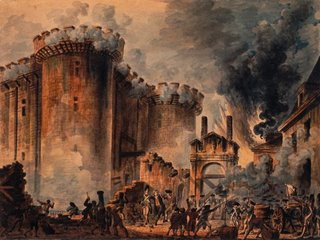
While reading Georges Lefebvre's 1939 history of The Coming of the French Revolution , I was struck by the uncanny similarities between the French monarchy's fiscal crisis -- the same crisis that destroyed Louis XVI's government -- and the financial problems of the modern United States government. The Bourbons ran regular budget deficits for most of the 18th century, and by 1788 the annual French deficit had grown to one-fifth of the size of total government outlays. Lefebvre quotes a 1788 budget forecast projecting public expenditures of 629 million livres and revenues of 503 million livres, resulting in a nominal deficit of 126 million livres. The actual deficit, however, was ultimately higher because a poor harvest throttled tax revenues.
Meanwhile, decades of borrowing had created a mammoth national debt and interest payments that crowded out other forms of public spending. In 1788 the French government spent 25% of its money on royal and civil expenses, another 25% on its army and navy -- and a crippling 50% on debt service. France's creditors had reached the end of their patience and would no longer loan money without huge concessions: the national Bank of Discount, for instance, only agreed to float a 100-million-livre loan if the King allowed its notes to circulate as legal tender. (Lefebvre, pp. 21-22)
The regime could not raise existing taxes to cover the shortfall because the commoners, who paid most taxes, had no more money to give. Between 1741 and 1785 "prices had risen 65 per cent and wages only 22 per cent" (p. 23); meanwhile, rents rose by 98%. As in the modern United States, the earnings of ordinary workers -- laborers and tenant farmers, in this case -- were stagnating or declining relative to inflation, while a few landlords and merchants were getting quite rich. Moreover, the wealthiest Frenchmen -- bishops, aristocrats, and rich bourgeois -- were partially or totally exempt from paying taxes. Sound familiar?
The French monarchy had only two ways out of its bind: it could inflate its debt out of existence, which in practice it was beginning to do (by monetizing the Bank of Discount's notes), or require the privileged orders to pay their fair share of taxes. When the King and his councillors chose the latter course, they caused the Breton nobility to rise in rebellion, and other nobles and jurists to demand the calling of the Estates-General, a concession which Louis XVI finally granted and which led to the end of the Old Regime.
The early 21st-century United States hasn't reached the same crisis point, but the comparable data are not reassuring. In FY 2006 U.S. tax receipts equalled $2.18 trillion, over 80% of which came from income and FICA taxes, while outlays equalled $2.57 trillion. 11% of last year's outlays ($390 billion) were financed with deficit spending. Interest payments on the national debt ($210 billion) equalled 8.2% of federal expenditures -- well below the French level, but greater than annual federal spending on Medicaid or combined annual federal spending on education, the environment, and foreign aid, and close to half of the United States' current defense spending (17%).* Finally, median household income in the United States has been stagnant since 1973 and has dropped an average of 2.8% since 2000, while prices have risen 17.5% during the past six years and 365% since 1973. (Sources: Concord Coalition, Washington Monthly [citing U.S. Census Bureau figures], Inflation Calculator.)
Is the United States on the verge of its own Bastille Day? Not exactly -- but we've been headed in that direction for thirty years (the late 1990s excepted), and some of our leaders seem determined to speed up the parade.
* The largest federal expenditures remain Social Security, Medicare, and Medicaid, which collectively account for 45% of the budget; Paul Krugman isn't exaggerating when he calls the U.S. government "a mammoth insurance company with an incorporated army."

No comments:
Post a Comment